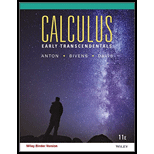
(a)
To calculate: The following where the equation, r=13+cosθ .
(i) Identification of the polar graph as a parabola, an ellipse or a hyperbola.
(ii) Whether the directrix is above, below, to the left or to the right of the pole.
(iii) Find the distance from the pole to the directrix.
(b)
To calculate: The following where the equation, r=11−3cosθ .
(i) Identification of the polar graph as a parabola, an ellipse or a hyperbola.
(ii) Whether the directrix is above, below, to the left or to the right of the pole.
(iii) Find the distance from the pole to the directrix.
(c)
To calculate: The following where the equation, r=13(1+sinθ) .
(i) Identification of the polar graph as a parabola, an ellipse or a hyperbola.
(ii) Whether the directrix is above, below, to the left or to the right of the pole.
(iii) Find the distance from the pole to the directrix.
(d)
To calculate: The following where the equation, r=31−sinθ .
(i) Identification of the polar graph as a parabola, an ellipse or a hyperbola.
(ii) Whether the directrix is above, below, to the left or to the right of the pole.
(iii) Find the distance from the pole to the directrix.
Want to see the full answer?
Check out a sample textbook solution
Chapter 10 Solutions
Calculus Early Transcendentals, Binder Ready Version
- Find the indefinite integral using the substitution x = 5 sin(e). (Use C for the constant of integration.) 1 dx (25-x²)3/2arrow_forwardFind the indefinite integral using the substitution x = 7 sec(0). (Use C for the constant of integration.) √ ׳ √x² - 49 dxarrow_forward2 Graph of h 6. The graph of the function h is given in the xy-plane. Which of the following statements is correct? , the graph of h is increasing at an increasing rate. (A) For (B) For (C) For 苏|4 K|4 π π , the graph of h is increasing at a decreasing rate. 2 0 and b>1 (B) a>0 and 01 (D) a<0 and 0arrow_forward
- 3. Consider the sequences of functions fn: [-T, π] → R, sin(n²x) n(2) n (i) Find a function f : [-T, π] R such that fnf pointwise as n∞. Further, show that f uniformly on [-T,π] as n→ ∞. [20 Marks] (ii) Does the sequence of derivatives f(x) has a pointwise limit on [-7,π]? Justify your answer. [10 Marks]arrow_forwardGood Day, Please assist with the following. Regards,arrow_forwardFor each given function f(x) find f'(x) using the rules learned in section 9.5. 1. f(x)=x32 32x 2. f(x)=7x+13 3. f(x) = x4 4. f(x) = √√x³ 5. f(x) = 3x²+ 3 x2arrow_forward
- Algebra & Trigonometry with Analytic GeometryAlgebraISBN:9781133382119Author:SwokowskiPublisher:Cengage
 Trigonometry (MindTap Course List)TrigonometryISBN:9781305652224Author:Charles P. McKeague, Mark D. TurnerPublisher:Cengage Learning
Trigonometry (MindTap Course List)TrigonometryISBN:9781305652224Author:Charles P. McKeague, Mark D. TurnerPublisher:Cengage Learning Trigonometry (MindTap Course List)TrigonometryISBN:9781337278461Author:Ron LarsonPublisher:Cengage Learning
Trigonometry (MindTap Course List)TrigonometryISBN:9781337278461Author:Ron LarsonPublisher:Cengage Learning


